
Epidemiological surveillance is a continuous collection of epidemiological data (treatment results) to trace the dynamics of incidence or spread over a significant time span. Data of epidemiological surveillance are collected and generalized at all levels from local to the national one. The data of the surveillance reflect the course of the epidemics at the level of treatment results; however, it is not always possible to see the impact of this or that particular program.
Rising TB incidence that had been witnessed in the country since 1998 was stopped in 2004, and starting from 2007, a decrease in TB incidence has been registered: its annual rate reached 3.3%. According to WHO, estimated TB incidence in 2014 was 96 cases per 100,000 population.
According to WHO (WHO Global TB Report for 2014, hereinafter – the WHO Report), estimated TB spread and incidence in Ukraine has been decreasing since 2007 by 4.4% and 3.3% respectively (fig.1). However, current indicators of TB spread exceed by three times the “Stop TB” partnership targets determined at the level of 36 cases per 100,000 population.
Estimated TB incidence and registration of TB cases (new and relapsed) in Ukraine, 1990-2013.*
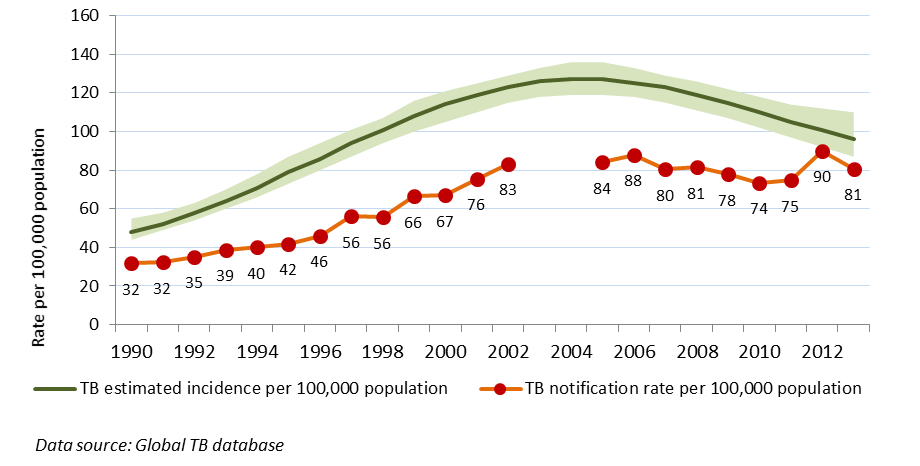
The number of newly registered TB cases in 2009-2014 remains stable, but an increase in TB relapses was witnessed in 2010-2014, which is caused by the spread of HIV-infection and MDR-TB in the region.
The dynamics of the number of newly detected and recurrent TB cases; a share of the previously treated TB cases according to the WHO Report.
The number of newly detected and recurrent TB cases and the share of the previously treated TB cases, 2003-2013*
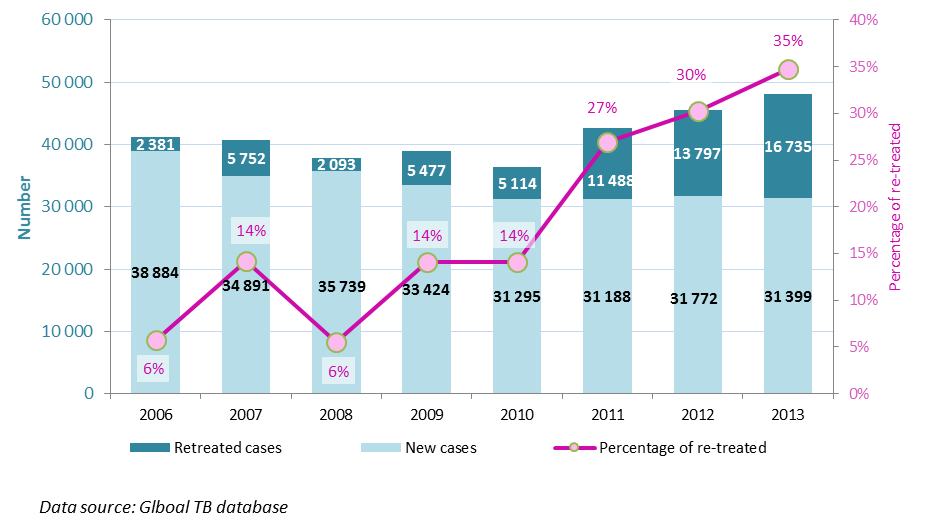
In 2014, the highest incidence indicator for all active TB forms was registered in South-Eastern regions of the country, where powerful tuberculosis facilities of the penitentiary system are located.
Active TB incidence (newly detected cases per 100,000 population) in Ukraine, 2014
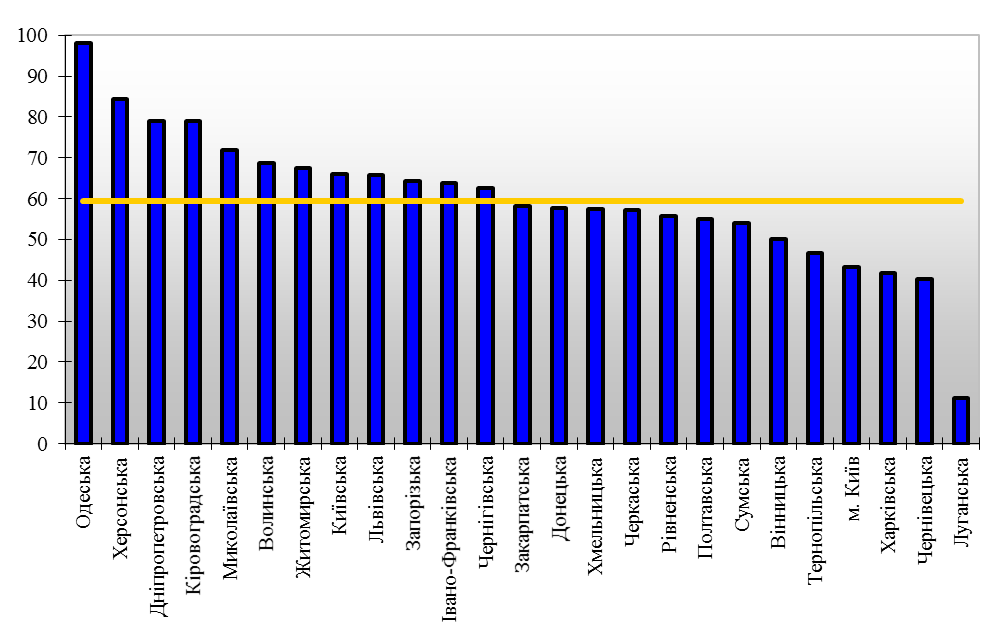
In 2014, in comparison to 2013, a decrease in TB incidence was registered in all regions of Ukraine, except Volyn (incidence increase by 1.9%), Khmelnytsk (by 3.4%), and Lviv (1.4%) regions, which is caused by harmonization of statistical reporting in the abovementioned regions.
According to WHO Report, a tendency towards decrease in TB incidence in “14-24” and “25-34” age groups has been registered over the last five years. This confirms a strong tendency towards TB burden decrease in the country.
Dynamics of TB cases registration in children divided by age groups; a share of pediatric tuberculosis among all new TB cases in Ukraine, 2008-2013*
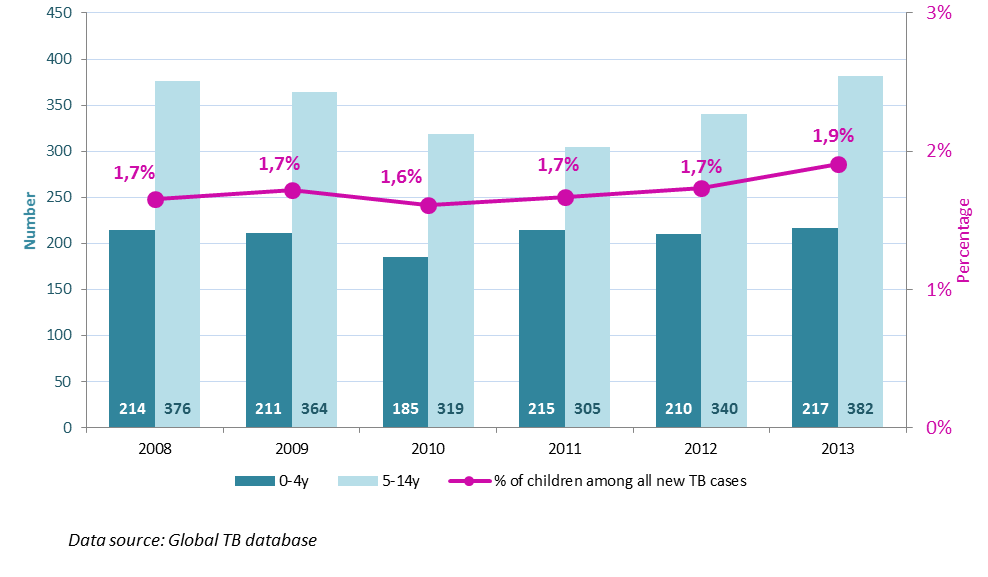
The analysis of social structure of the newly detected TB patients in 2014 shows that about 70% of new TB cases involved representatives of socially vulnerable groups:
58.3 % - unemployed persons of working age,
12.5 % – retirees,
2.4 % – persons without a permanent place of residence;
1.0 % – persons who returned from penal institutions.
The number of medical staff who contracted TB – 1.4% of the general number of patients – raises concerns. This figure includes doctors and nursing staff (217 persons – 0.8%) and results from inadequate means for infection control in prevention and treatment facilities.
Patients abusing alcohol amounted to 12.1% of the newly registered TB cases of the 1st and 3rd registration categories, while injection drug users accounted for 7.0% of cases, which proves the need to develop national programs to support patients on conditions of active participation of civil society institution.
Detection of extrapulmonary tuberculosis cases deserved special attention, for in 2014 its indicators were as follows:
extrapulmonary TB of respiratory organs – 58.8 % (58.2 % in 2013);
tuberculous rheumatism – 17.1 % (17.8 % in 2013);
peripheral tuberculous lymphadenophathy – 8.3 % (8.7 % in 2013);
urogenital tuberculosis – 5.0 % (5.5 % in 2013);
eye and nervous system tuberculosis – 6.5 % (5.9 % in 2013);
other TB focalization – 4.3 % (3.9 % in 2013)
Comparing 2014 to 2013, it can be claimed that active TB incidence in combination with AIDS decreased only by 0.9% and reached 10.4 cases per 100,000 population, while mortality due to this pathology decreased by 17.8% (4.6 cases per 100,000 population).
A noticeable increase in the number of HIV/TB co-infection (19.6%) reflected the increasing burden of HIV-infection in the country (fig. 7). Along with that, ART coverage is insufficient; its level is 56% (while it is recommended to have a 100% coverage).
Incidence and mortality due to TB and active TB in combination with AIDS (per 100,000 population)
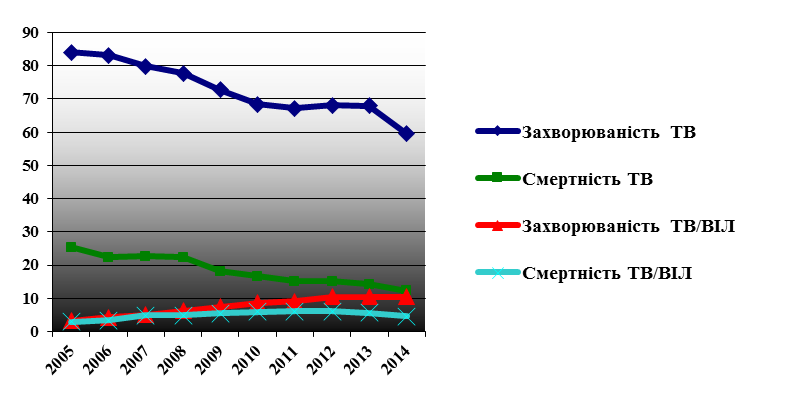
Due to establishment of cooperation with the specialists of tuberculosis facilities and centers for prevention and fighting AIDS in regard to provision of comprehensive assistance to patients with HIV/TB co-infection in 2014, HIV testing of TB patients reached 96.9% (85% in 2013).
A tendency towards the increase of ART coverage of TB/HIV patients from 47.6% in 2013 to 55.9% in 2014 was witnessed.
In comparison to 2013, the prevalence indicator for all active TB forms in 2014 decreased by 14.4% (from 105.4 cases per 100,000 population in 2013 to 90.2 in 2014).
According to the analysis of territorial distribution of patients with all active TB forms, in 2014, high prevalence indicators were found in Kherson (131.2 per 100,000 population), Mykolayiv (130.0), Dnipropetrovsk (125.5), and Kirovohrad (119.7) regions, which exceeded the average Ukrainian indicator by 1.4 times. Low indicators of prevalence of all active TB forms in 2014 were found in Khmelnythskyi (59.8 per 100,000 population) and Ternopil (64.9) regions, and the city of Kyiv (61.6).
Since 2006, TB mortality rate in Ukraine has been decreasing, on average, by 7.6% a year; however, these rates are insufficient to fulfil the tasks of the Stop TB partnership strategy and attain the targeted indicators of TB mortality rates of 4.8 cases per 100,000 population.
TB mortality rate in 2014 (according to the State Statistics Service of Ukraine) decreased by 13.5% in comparison to the previous year and reached 12.2 per 100,000 population. This tendency proves the efficiency of anti-TB measures and is primarily connected with adequate provision for the need of 1st-line antituberculosis drugs.
*Source: WHO Report

